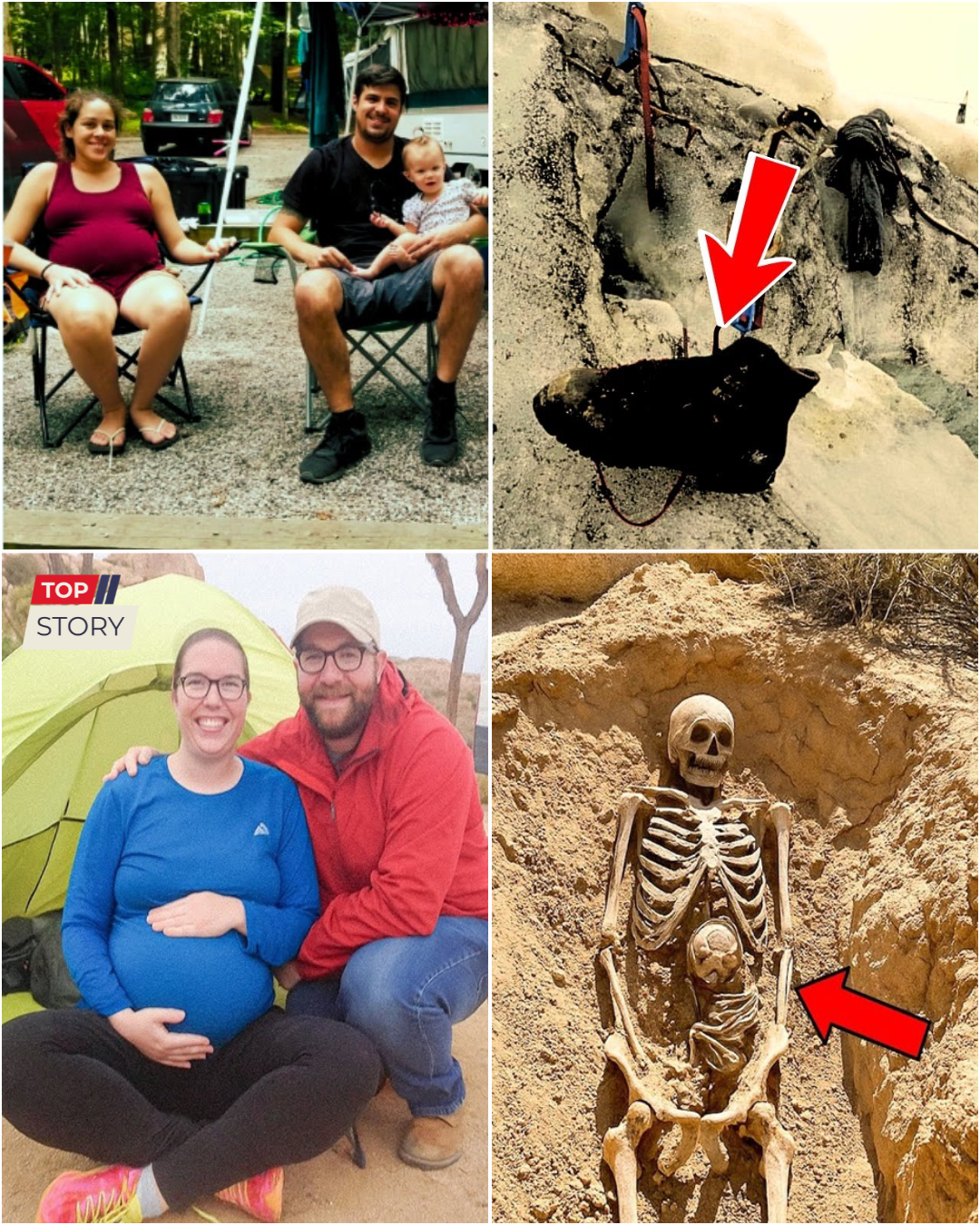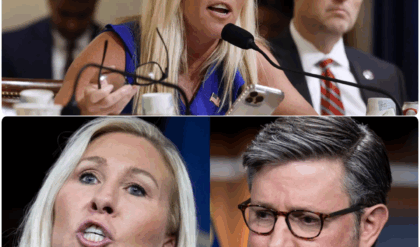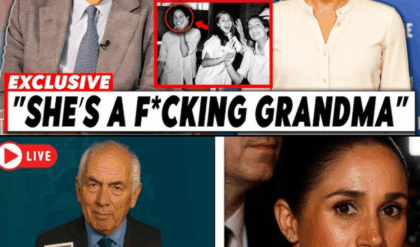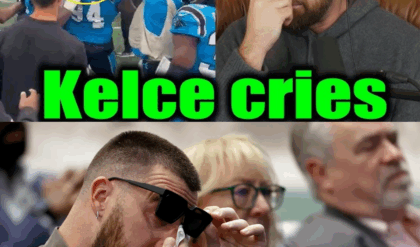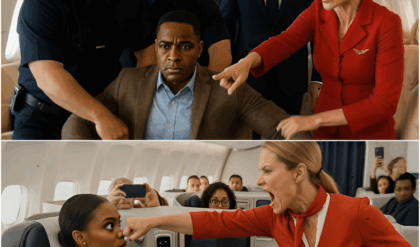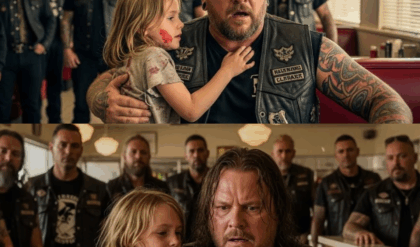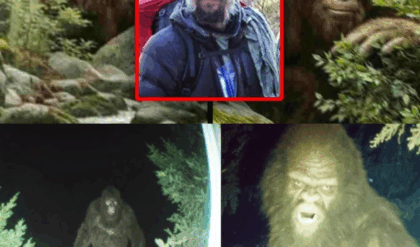The picture looked like happiness carved in sunlight.
Jenna Dinger, seven months pregnant, sat cross-legged beside a bright-green tent, the wind teasing her hair. Her husband Marcus crouched behind her, one arm wrapped around her shoulders, the other raised in a half wave toward the camera. Behind them, a white camper van shimmered under the desert gold of Joshua Tree.
You could almost hear the click of the shutter — a small sound swallowed by miles of sand and silence.
That photograph would become famous.
It would appear on missing-person posters, in news segments, and finally in the closing shot of every documentary made about them.
But on that Saturday evening in 2011, it was just a keepsake.
Jenna texted her sister before turning in for the night:
The desert is beautiful. Love you.
Khloe saved the message, not knowing those four words would be the last her sister ever sent.
The Vanishing
Sunday morning came bright and windless. Khloe waited for the usual call — Jenna checking in, laughing about how Marcus had burned breakfast or how the desert sun felt like another planet.
Ten o’clock passed. Then noon. Then evening.
By nightfall, Khloe’s unease hardened into fear. She called again. Straight to voicemail.
“Jenna never let her phone die,” she told reporters later. “She was meticulous, especially being pregnant. She checked in every day.”
By midnight she had the park rangers on the line.
The Search
The first sweep began before dawn. A ranger jeep traced the long dirt road leading into the northern valley of Joshua Tree, guided by the coordinates from the couple’s camping permit.
At 6:43 a.m., the team found the white van.
Everything was neat. Too neat.
The green tent still stood.
The chairs faced east, perfectly aligned with the sunrise.
Two mugs sat on the foldout table, each ringed with the brown stain of coffee that had long gone cold.
Keys in the ignition.
Wallets in the glovebox.
Camera bag under the table.
Inside the tent — sleeping bags unzipped, side by side.
And on the small camp stove, a pan of scrambled eggs turned to dust.
“Like time just stopped,” ranger Al Morales said later.
The forensic team photographed every inch of the site. No drag marks. No blood. No animal prints. The sand around the camp was smooth — as if the desert itself had erased their steps.
The first theory was heatstroke. Maybe they’d wandered off and gotten lost. But it was early spring; the temperature barely reached eighty.
Khloe arrived that afternoon, pale and trembling. She recognized her sister’s handwriting on a list taped to the van door — Water. Snacks. Prenatal vitamins.
She reached for the list, then stopped herself, afraid to disturb it.
The Hours That Turned to Years
For two weeks, Joshua Tree became a grid of human determination. Helicopters combed the sky. Search dogs barked and whined in the endless sun. Volunteers formed lines across the ridges, each step crunching over stone and cactus.
The air smelled of dust and diesel and fear.
Nothing.
A month later, the official search was scaled back. The desert had swallowed them whole.
By summer, television crews packed up. Reporters moved on to fresher tragedies.
All that remained was Khloe — a single voice calling into the wind.
Suspicion
When the investigation shifted from rescue to inquiry, Marcus quickly became the center of every rumor.
Financial records showed overdue credit cards, a failing business, late mortgage payments.
“Maybe he snapped,” one detective said off the record. “Maybe the pressure got to him.”
The narrative was easy, almost comforting: the husband as villain.
News anchors said phrases like domestic tension and money motive.
Headlines read: “Pregnant Woman Vanishes — Husband Under Scrutiny.”
Khloe refused to listen.
“He built the baby crib himself,” she told a local paper. “He painted the nursery yellow because Jenna said blue was too sad. That’s not a man who kills.”
Still, evidence was thin. With no bodies, no struggle, the case slid quietly into the cold-case database.
The Silence Between Sisters
Every year on Jenna’s birthday, Khloe returned to Joshua Tree.
She would drive to the same trailhead, park beside the warning sign, and walk until the heat shimmered. There, she’d place fresh sunflowers in the sand and play a voicemail Jenna had left her weeks before the trip.
In the recording, Jenna laughed — that easy, musical laugh that made everyone else join in.
“I can’t wait for you to meet the baby. We’re thinking of naming her Grace if it’s a girl. Marcus says she’ll have your stubborn streak.”
Khloe would replay the message three times, then whisper, “I’m still looking.”
The Desert Keeps Its Secrets
By 2017, the case was little more than a file box in the San Bernardino sheriff’s archives.
The white van, still technically evidence, sat under a canvas tarp in a storage yard behind the precinct. Its paint had dulled to chalk; the tires sagged.
On the sixth anniversary of the disappearance, Deputy Cole Anderson walked out to sign the release papers. Procedure required one last inspection before returning property to next of kin.
He lifted the tarp. Dust rolled off in clouds.
Inside the van, time had frozen — camping gear stacked neatly, clothes folded, food cans still labeled in Marcus’s handwriting.
Everything matched the old inventory list.
Except one thing.
A thin rectangle of metal near the rear panel didn’t sit flush. When Cole pressed it, it gave a hollow click.
He frowned, fetched a screwdriver, and pried the panel loose.
Behind it was a sealed cardboard tube wrapped in duct tape.
Cole slit the tape with his pocketknife. Out slid a bundle of maps — large, detailed, creased with use.
Across each page, red ink lines zigzagged through coordinates, symbols, and handwritten notes:
pegmatite dikes,
thorite veins,
rare earth mineral sites.
The deputy turned one map toward the light. The ink shimmered slightly, as though someone had gone over it more than once.
At the bottom corner, written in a neat block hand, were two words:
“Phase 3 — secure.”
Cole stood for a long moment, the paper rustling between his fingers, the wind outside whispering through the storage lot.
Something about those maps felt alive — like a voice calling from under the sand.
He took photos, logged the discovery, and forwarded them to the investigative unit.
That night, a storm swept across the desert, lightning slicing through the sky above Joshua Tree.
For the first time in six years, the case file of Jenna and Marcus Dinger was reopened.
The next morning, Khloe’s phone rang.
When she heard the deputy say the words “We found something in the van,” she gripped the receiver until her knuckles turned white.
She didn’t ask what — not yet.
Because somewhere deep down, she already knew the desert had finally decided to speak.
And it never speaks gently.
The maps covered the entire desk like veins of some living creature.
Detective Sara Villanueva stood above them, eyes narrowed, tracing the red lines with her fingertip. “These aren’t random,” she murmured. “They’re geological surveys.”
Beside her, an older man in khaki leaned closer. Dr. Harlan Pike, a retired geologist the department had brought in for consultation, adjusted his glasses. “Whoever made these knew what they were looking for. Pegmatite dikes, thorite traces… rare earth minerals. These markings are precise — professional.”
He glanced at the evidence tag. “You said the husband, Marcus, drew these?”
Sara nodded. “At least, we think so.”
Harlan exhaled. “Then he wasn’t running from debt. He was chasing a discovery.”
The room went quiet except for the hum of the ceiling fan. Outside, heat rippled over the Mojave horizon.
Sara leaned over the maps again. “Every one of these coordinates sits miles off the tourist trails. If he was prospecting illegally, he might’ve crossed paths with someone who didn’t want him there.”
Harlan’s gaze sharpened. “If that’s true, you’re not looking for a missing couple anymore. You’re looking for a cover-up.”
The Map Leads the Way
A new search began.
Helicopters sliced across the sky over Joshua Tree once more, stirring up waves of ochre dust. Ground units marked the coordinates from Marcus’s maps onto GPS trackers. The desert, quiet for so long, buzzed again with the sound of engines and radio chatter.
Khloe watched from the command tent, her fingers twisting the ring Jenna had given her in high school. She’d been here before — the same wind, the same hopelessness — but this time, something felt different.
The first few sites revealed nothing. Just sunburned rock and time.
But then, the eleventh location — a narrow canyon hidden behind massive granite boulders — gave them pause.
The sand looked disturbed, not recent, but not natural either. A faint mound, barely visible, caught the light at a strange angle.
Detective Villanueva crouched and brushed her glove over the surface. Beneath a thin crust of sand, something white gleamed.
Bone.
The site froze. The radios went silent.
Forensic teams arrived before sunset, setting up floodlights that painted the boulders in a harsh blue glow. Each grain of sand was lifted with surgical care.
By dawn, the shape had emerged — the curled form of a woman lying on her side, her hands drawn close to her chest, as if protecting something.
Inside her pelvis, small, delicate bones rested undisturbed.
A mother and child, entombed together beneath eleven years of silence.
The Desert Gives Up Its Secret
When the DNA results came back, no one was surprised — but everyone fell silent anyway.
It was Jenna Dinger.
The news broke nationwide within hours:
“Remains of Missing Joshua Tree Couple Found After 11 Years — Husband Still Missing.”
Reporters swarmed the sheriff’s office. Old rumors reignited like wildfire.
“Maybe he buried her and fled.”
“Maybe he staged the whole thing.”
Khloe watched the footage in her living room, fury rising like bile. The headlines made Marcus sound like a ghost with blood on his hands.
She turned off the TV. “He didn’t kill her,” she whispered. “I know he didn’t.”
The Metallic Clue
Forensic analyst Megan Cho examined Jenna’s bones under the scanning microscope. She expected dust, mineral traces, maybe small animal interference. What she didn’t expect were the glittering particles embedded in the bone pores.
She frowned and leaned closer. The readings came back high in thorium.
“Thorite,” she whispered. “Natural radioactive mineral.”
It wasn’t something that just happened in the desert — it came from mining activity. Someone had dug in that spot.
Her report hit the desk of Detective Villanueva two days later. Within an hour, Sara was on the phone with Dr. Pike.
“This confirms it,” he said gravely. “Whoever buried her wasn’t just hiding a body. They were working that ground.”
The Man in the Shadows
Marcus’s name cleared itself slowly through logic more than sympathy. The thorite evidence meant the burial site was an active dig, and only a few people in Marcus’s world had the expertise to find it.
One of them was Leland Croft.
A name that had appeared briefly years ago in Marcus’s business filings — an old partner from a geological consulting firm that went bankrupt before the Dingers disappeared.
When Villanueva visited the archives, she found Croft’s signature on old mineral survey permits, many overlapping Marcus’s map coordinates.
She called the mining bureau. “Has anyone named Croft registered claims in the Mojave area?”
The clerk hesitated. “No active claims… but there’s a record of equipment orders. Drilling gear. Purchased cash.”
Sara hung up slowly. The air in her office felt suddenly heavy.
The Meeting That Never Ended
They found Croft living in a quiet neighborhood outside Palm Springs, in a house that looked expensive but tired — a man living on borrowed money and borrowed time.
He opened the door wearing a linen shirt and a brittle smile. “Detective,” he said politely. “This about the Dingers again?”
Sara studied him. His hands trembled slightly when he gestured her inside.
“We found Jenna,” she said.
The color drained from his face. “Oh.” He sank into a chair. “Where?”
“One of Marcus’s coordinates.”
He stared at her, eyes wide. “Marcus… had coordinates?”
“He left maps,” Sara said quietly. “Detailed ones. With notes in red ink. Handwriting analysis is pending, but I thought you might recognize it.”
She slid a photocopy across the table.
Croft’s eyes flickered. He didn’t touch the paper.
“Beautiful penmanship,” he said after a long pause.
Sara leaned forward. “Funny. Because yours is identical.”
The Weight of Truth
The confession didn’t come easily. It took two hours of silence, a coffee gone cold, and one sentence from the detective that finally broke him:
“She was seven months pregnant, Leland. She begged you to let her live.”
He exhaled once, long and shaky. “Marcus found out,” he began. “About the prospecting. He said he’d report me to the Bureau. I just needed time — time to get out before the fines, the charges.”
He rubbed his face with both hands. “I told him to meet me in the desert. I said we’d talk it out. Jenna came too. She didn’t want him going alone.”
Sara said nothing.
Croft’s voice cracked. “He accused me, started yelling. I don’t even remember hitting him. He fell — just fell. And then she screamed. I panicked.”
He swallowed hard. “I buried her where he’d planned to dig. I thought… it would look like he ran.”
The tape recorder clicked softly in the background.
The Desert Testifies
Two weeks later, searchers located Marcus’s remains at the bottom of an abandoned mine shaft fifteen miles from Jenna’s burial site. His wedding ring still clung to bone.
When the forensic team lifted it into daylight, Khloe wept. Not from shock — from vindication.
“He never left her,” she whispered.
The trial that followed gripped the nation. Every network aired footage of the courtroom — the calm voice of Detective Villanueva recounting the discovery, the tearful testimony of experts, the haunting display of the last photo on the projector.
Croft sat motionless through it all, eyes fixed on the floor as the prosecutor’s words echoed:
“He didn’t just kill a man and his wife.
He killed their future — and hid it beneath the sand.”
The verdict came swiftly. Guilty on all counts.
The Letter
After sentencing, Detective Villanueva found a sealed envelope among Croft’s confiscated belongings. It was addressed to “The Sister.”
She forwarded it to Khloe, who opened it alone at her kitchen table.
The handwriting was messy, uneven.
“I don’t expect forgiveness. I see their faces every time I close my eyes.
I buried them where the earth glowed — thought the desert would keep my secret.
It didn’t. I hear it whispering still.”
Khloe folded the letter, tears falling onto the ink until the words blurred.
That summer, she returned once more to Joshua Tree.
The air shimmered with heat; the rocks hummed faintly in the wind.
She placed three stones in the sand:
one for Jenna,
one for Marcus,
one for the child they never met.
Then she whispered, “You can rest now.”
The desert stretched endlessly before her, quiet and golden.
It had hidden its secret for eleven years.
Now it had told its story.
The courtroom emptied slowly, like air leaving a lung.
Journalists packed up their cameras, murmuring into microphones. The verdict—guilty on all counts—was already running across the evening news ticker.
Khloe stayed seated long after everyone else had gone.
The bench creaked softly beneath her. In front of her, the judge’s chair sat empty, the flag motionless. She stared at the spot where Croft had sat—motionless too, his expression a strange blend of fear and exhaustion.
For eleven years, she had lived in the shadow of this story.
Now it was over.
And yet, it wasn’t.
Because endings never arrive with the neatness of a verdict. They come slowly, in echoes, in the space between breaths.
The Box
A week after the sentencing, Khloe received a call from the evidence department.
“There are items belonging to your sister,” the officer said. “We can release them now.”
She drove to the precinct and signed the paperwork with trembling hands.
The clerk handed her a small cardboard box, the kind used for shipping books. Inside were the artifacts of a life that had once been ordinary: Jenna’s phone, her wedding band, a folded blanket that still smelled faintly of lavender.
At the very bottom lay a manila envelope marked “PERSONAL EFFECTS – CAMP.”
Inside was a single Polaroid.
The Last Photo.
Khloe lifted it carefully, her thumb brushing the faded edge. The image had aged; colors muted to amber and blue. But the smiles were still there—Jenna glowing with life, Marcus’s arm around her, the desert behind them painted in impossible light.
She traced their faces with her thumb and whispered, “I found you.”
The Story Spreads
The media storm didn’t fade. If anything, the trial had turned the case into an American myth. Documentaries, podcasts, even an episode on Dateline.
“The Last Photo,” one headline read, “and the Map That Solved It All.”
But Khloe didn’t watch any of it. She stopped answering reporters. She turned off the television.
She didn’t need the world’s version of her sister’s story.
She already knew the real one.
At night, she dreamed of sand. Not the suffocating kind from her nightmares, but the gentle rustle of wind over dunes—like a whisper of peace returning.
The Return to Joshua Tree
It was late autumn when Khloe decided to go back.
The desert greeted her the same way it had before: endless sky, slow wind, the kind of silence that pressed against the chest like a memory.
She drove past the visitor center, down the cracked road that led toward the old campsite.
The land had changed and hadn’t. New grass grew in patches where the searchers’ footprints had once trampled the dust. The granite boulders stood exactly as they always had—ancient, patient, unbothered by the tragedies of men.
Khloe parked and stepped out, the air warm against her skin.
She carried with her three things: a bouquet of yellow sunflowers, a small framed copy of the last photo, and a smooth stone she’d picked up from her own backyard.
When she reached the edge of the canyon, she placed the flowers down first.
Then the photo, propped carefully against the rock.
And finally, she stacked three stones beside it—one for Jenna, one for Marcus, one for the child who never took a breath.
The wind shifted, lifting her hair, carrying the faint scent of creosote and salt.
For a moment, she could almost hear Jenna laughing again.
The Monument of Silence
Over the months that followed, hikers began to leave their own stones.
First one, then ten, then dozens—tiny cairns scattered among the rocks.
Word spread quietly through online hiking forums: “If you pass through Joshua Tree, stop by the memorial near the east ridge. Leave a stone. Tell them they’re not forgotten.”
It wasn’t official. No plaque, no coordinates, no guidepost.
But those who went there said the air felt different—still, reverent, almost sacred.
The rangers called it The Field of Stones.
Every sunrise painted it gold.
Every sunset turned it to fire.
And somewhere in that space between day and night, people swore they could hear the desert breathe.
The Desert’s Lesson
For Khloe, the desert no longer felt cruel. It felt honest.
It gave nothing, took everything, but in the end—it told the truth.
She often visited when the park was quiet, sitting near the stones as the wind whispered through the Joshua trees. Sometimes she brought coffee, sometimes just silence.
Once, a tourist recognized her.
“You’re her sister, right? Jenna?”
Khloe nodded.
“I’m so sorry,” the woman said softly. “That story… it broke my heart.”
Khloe smiled faintly. “It broke mine too. But it also taught me something.”
“What’s that?”
“That the truth doesn’t die,” she said. “It just waits for someone brave enough to dig it up.”
The woman didn’t answer. She simply added another stone to the growing pile, bowed her head, and left.
The Photograph
Back home, Khloe kept the original photo on her kitchen wall.
Every morning, sunlight filtered through the blinds and landed on it—the same time of day, the same angle.
Sometimes she imagined Jenna turning her head, laughing again, saying something about how the light in Joshua Tree made everything glow.
And sometimes, on especially quiet mornings, she’d catch her own reflection in the glass beside her sister’s smile and realize that, in some strange way, the two of them were still sharing the same frame.
The Echo That Never Fades
Years later, the story of Jenna and Marcus became part of desert folklore. Rangers told it to new recruits.
Campers whispered it by the fire.
They’d say, “If you ever see a single white van under the Joshua trees at dusk, take a photo—but don’t forget to look behind you. The desert remembers everything.”
It wasn’t superstition.
It was reverence.
Because the desert had hidden its secret for eleven years, and when it finally spoke, it spoke in truth.
The Final Visit
On the twelfth anniversary, Khloe made one last trip.
This time she brought someone with her—her teenage daughter, Grace.
The girl’s hair caught the same light Jenna’s once had. As they stood together, Khloe told her the story—not the tabloid version, but the one that lived in her heart.
“How did you find them?” Grace asked quietly.
“I didn’t,” Khloe said. “The desert did. I just didn’t stop listening.”
Grace looked out across the valley. “It’s beautiful here,” she said.
Khloe nodded. “It always was.”
She placed a hand on her daughter’s shoulder, guiding her to add one more stone to the pile.
When Grace did, the rock clicked softly against the others, joining the hundreds already there.
The sound was small, but it echoed.
Epilogue
At dusk, Khloe sat alone for a while longer.
The sun dipped behind the granite towers, painting the sky in a thousand shades of copper. The wind stirred, carrying a low hum that seemed to vibrate through the earth itself.
She closed her eyes and listened.
In that sound, she could hear it all — the laughter, the loss, the truth unearthed after years of silence.
She whispered one last time, “I found you, Jenna.”
Then she stood, brushed the sand from her knees, and turned toward the horizon.
Behind her, the photo frame caught the last ray of sunlight before the desert swallowed it whole again.
And under the endless sky of Joshua Tree, the story finally rested.
